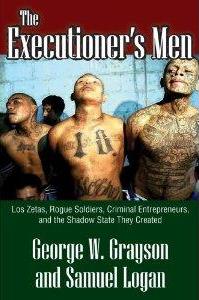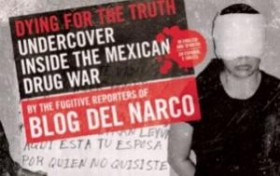The Executioner’s Men: Los Zetas, Rogue Soldiers, Criminal Entrepreneurs, and the Shadow State They Created, by George Grayson and Samuel Logan (2013, Transaction Publishers, 338 pp., $28.89 HC Amazon)
Dying for the Truth: Undercover Inside the Mexican Drug War, by the Fugitive Reporters of Blog del Narco (2012, Feral House, 389 pp., $18.68 PB Amazon)
 With the capture this week of Zetas leader Miguel Angel Trevino Morales, “Z-40,” Mexico’s most notorious drug cartel is front page news around the world. Originally composed of highly trained Mexican armed forces personnel gone over to the dark side, the Zetas served as praetorian guards for the Gulf Cartel of Osiel Cardenas Guillen — his enforcers and hitmen — before turning on their erstwhile employers after Cardenas’ 2004 arrest and striking out on their own.
With the capture this week of Zetas leader Miguel Angel Trevino Morales, “Z-40,” Mexico’s most notorious drug cartel is front page news around the world. Originally composed of highly trained Mexican armed forces personnel gone over to the dark side, the Zetas served as praetorian guards for the Gulf Cartel of Osiel Cardenas Guillen — his enforcers and hitmen — before turning on their erstwhile employers after Cardenas’ 2004 arrest and striking out on their own.
Now, the Zetas are locked in a murderous struggle with the Sinaloa Cartel of El Chapo Guzman for domination of Mexico’s multi-billion dollar drug smuggling industry. Other players — the Tijuana cartel of the Arrellano Felixes, the Juarez cartel of the Carillos Fuentes, the battened down remnants of the Gulf cartel, the former Sinaloa cartel allies the Beltran Leyvas, the Familia Michoacana and its successor, the Knights Templars — have seen their fortunes wax and wane, but mainly wane, in the multisided battle that pits the cartels not only against each other, but against the Mexican state. (Never mind for now that the war also pits various elements of the state against each other in service to the cartels.) The Zetas and the Sinaloa cartel have emerged on top, but they are standing on heaps of bloodied, broken bodies.
Some 80,000 people have been killed in the Mexican drug wars since former President Felipe Calderon declared war on the cartels in late 2006 and tens of thousands more have gone missing. Many of them are undoubtedly spending eternity in the unmarked (and rarely remarked upon) narcofosas (narco-graves) that dot the Mexican countryside. Those mass burial grounds are occasionally uncovered, with hazard-suited workers bringing up 10 bodies, 30 bodies, 100 bodies at a time. Many, if not most, of those mass graves are the work of the Zetas.
In The Executioner’s Men, named for Heriberto Lazcano Lazcano, the head of the Zetas for eight years until he was gunned down by Mexican marines last year, College of William and Mary Mexico drug war scholar George Grayson and coauthor Samuel Logan tell the sobering story of the group’s origins, its bloody-minded rise to prominence among the country’s competing cartels, and its steady expansion, both geographically into Central America and entrepreneurially into human smuggling, extortion, and other rackets. It is a highly researched and detailed account of one of the most sadistic criminal organizations on the planet.
The Mexican drug war has generated an extensive literature, much of which has been previously reviewed in these pages, but The Executioner’s Men stands out as a truly magisterial study of an organized crime group. With its (sometimes mind-boggling) naming of names and its contextualization of events, Grayson and Logan’s work will for years to come remain a crucial sourcebook for students of the Zetas and Mexico’s drug wars in general. Except they’re going to have to update it — it was written before the killing of El Exterminador Lazcano Lazcano, and now his immediate successor has been removed from the field of play, too.
Will the arrest of Z-40 mark the end of an era for the Zetas? Grayson suggested as much in post-arrest interviews this week, saying he thought they would decline into a number of squabbling factions. Others are not so sanguine, predicting lethal struggles for power among Zeta lieutenants and Sinaloa cartel moves to take advantage of the disarray in their rivals’ ranks. Only time will tell, and we await the next edition of The Executioner’s Men to make sense of what will be going down.
 If The Executioner’s Men is scholarly and erudite, Dying for the Truth is something entirely different, but equally powerful, if not more so. It reprints verbatim (in English and Spanish on alternating pages) a year in the life of the Blog del Narco, a Mexican web site that appeared late in the last decade to chronicle the drug war stories it claimed the mainstream Mexican press was too terrified to cover. (There is some controversy over this and other claims made by Blog del Narco lead author “Lucy,” who has fled Mexico in the wake of the killings of two of her collaborators and the disappearance of another. Here is Bernd Debusmann Jr.’s take on it.)
If The Executioner’s Men is scholarly and erudite, Dying for the Truth is something entirely different, but equally powerful, if not more so. It reprints verbatim (in English and Spanish on alternating pages) a year in the life of the Blog del Narco, a Mexican web site that appeared late in the last decade to chronicle the drug war stories it claimed the mainstream Mexican press was too terrified to cover. (There is some controversy over this and other claims made by Blog del Narco lead author “Lucy,” who has fled Mexico in the wake of the killings of two of her collaborators and the disappearance of another. Here is Bernd Debusmann Jr.’s take on it.)
The Mexican press had and has reason to be frightened; the country is one of the most dangerous in the world for journalists. At least 84 reporters have been killed since 2000 and another 20 or so have simply vanished, according to Mexican human rights sources. Many — though by no means all — have been killed by the narcos for paying too much attention to them and their doings.
Blog del Narco (which I followed online during 2010, the year covered in the book) said it would provide the coverage missing from the mainstream press, and whether or not it cribbed material from other outlets, it also presented much information that would otherwise have never have seen the light of day. Its blogging format allowed anonymous contributors to post items, which in turn allowed the cartels to use it as a medium for sending messages. Too often, those messages were sent via horrifying videos or photos. If they were designed to terrify, it works. (This, too, has raised questions about just what Blog del Narco was trying to accomplish.)
If it were a work of literary artifice, Dying for the Truth would be wildly and stunningly successful. Like JG Ballard doing bad acid after a three-day meth bender, the anonymous contributors drag readers through a nightmarish and surrealistic Grand Guignol via a multimedia mix of torture/execution videos, interrogation transcripts (almost always followed by the execution of the prisoners by heavily armed masked men in paramilitary garb), gruesome atrocity exhibition photos (skinned faces sewn onto soccer balls, anyone?), charts and graphs, and the day-by-day killings, bombings, shootouts and busts that constitute Mexico’s drug wars.
But unfortunately, Dying for the Truth is no work of inventive fiction. It is all too real, as are the dismembered, disemboweled, and decapitated victims whose remains it displays. WARNING: DO NOT BUY OR EVEN LOOK AT THIS BOOK IF YOU CANNOT TOLERATE HORRIFIC IMAGERY. This is deeply, deeply disturbing stuff. I watched some of those videos when they first appeared on Blog del Narco, and they will haunt me for as long as I live.
Warnings aside, Dying for the Truth serves purposes beyond spreading narco-messages and scaring the hell out of people. Once you get past (or block out) the imagery, you have a fairly comprehensive narrative of a bloody year in Mexico’s bloody drug wars. Those killings that may appear senseless when they sporadically show up in US media accounts — 13 handcuffed bodies found on the roadside here, a row of human heads sitting in a park there, a pile of dismembered body parts over there — take on a certain savage logic when chronicled as tit-for-tat responses in an ongoing battle between amoral killers.
Drug prohibition cannot be blamed for the sadistic savagery of Mexico’s drug wars. At the risk of sounding like a pop psychology pontificator (and suffering the “national character” fallacy), I would suggest there is something in the Mexican national character at play here. It is a society founded by two competing bloody theocracies, the human-sacrificing Aztecs on one hand and the “Cross and Sword” Spanish Catholics on the other. It’s the country of Posada’s famous skeletons and the candy skulls of Day of the Dead. It’s the country where the statues of Christ in the Catholic cathedrals are the bloodiest and most wounded anywhere. It’s the country where tabloids like !Alarma! have specialized for decades in displaying dead and battered bodies. Add in lots of booze and cocaine, multi-billion dollar stakes, ruthless military training, deep-rooted corruption and brutality, and here we are.
That said, while there may be something in the Mexican psyche that has turned these cartel wars into the stuff that would give Syrian jihadis the heebie-jeebies, it is of course drug prohibition that has provided the oxygen that allows such evil to flourish. Given the spread of the cartels into other economic spheres, even if we were to legalize everything tomorrow, this nightmare isn’t going away easily. But that would be a good start.
Article republished from Stop the Drug War under Creative Commons Licensing









